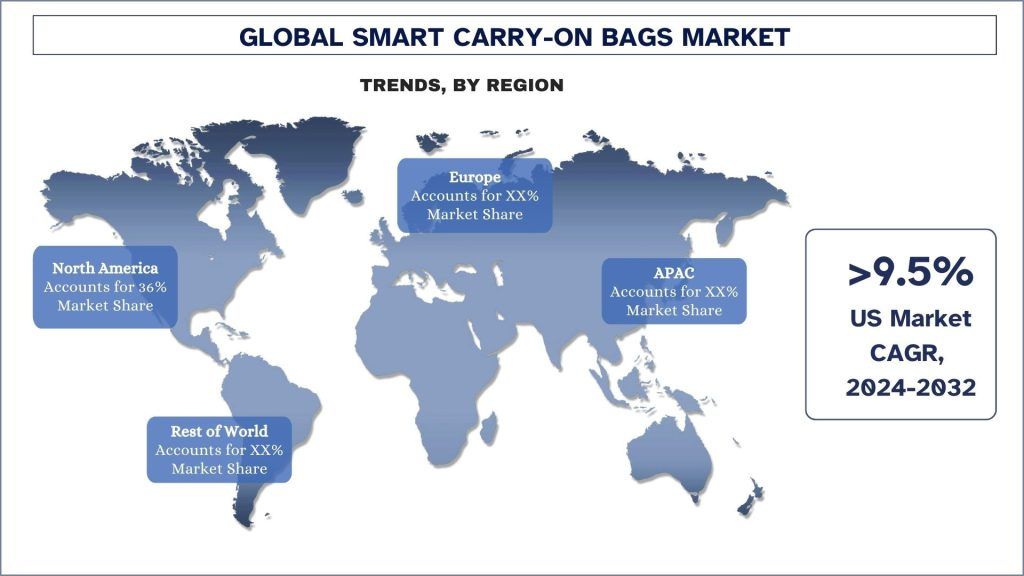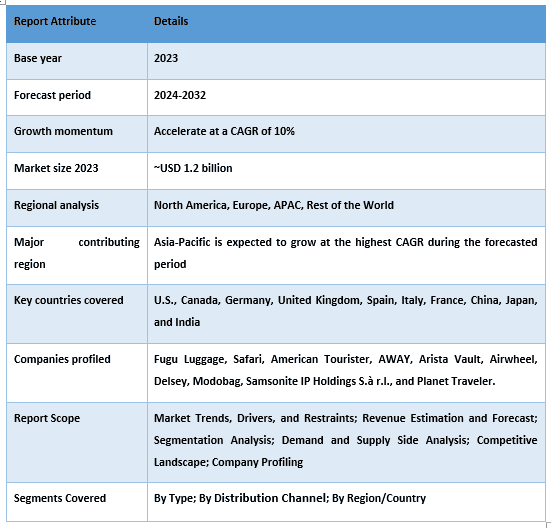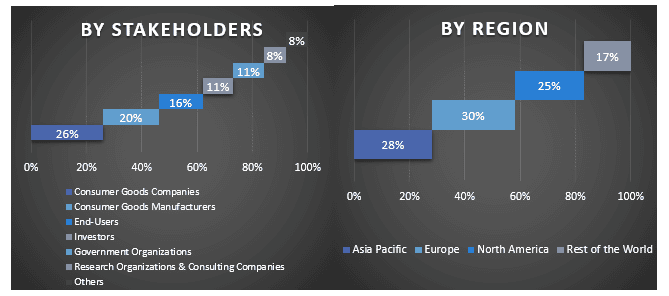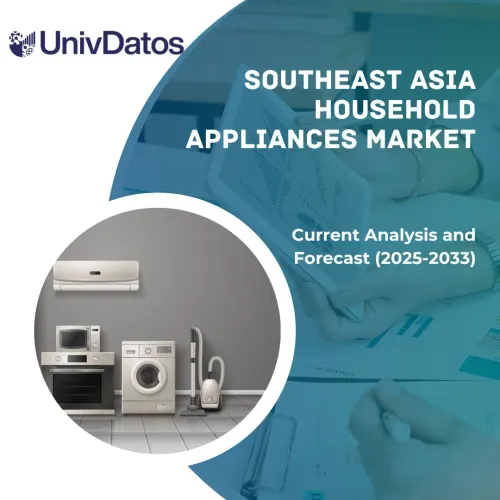- Home
- About Us
- Industry
- Services
- Reading
- Contact Us
Smart Carry-On Bags Market: Current Analysis and Forecast (2024-2032)
Emphasis on Type (USB Charging, Connectivity, and Sensors); Distribution Channel (Online and Offline); Region/Country.

Smart Carry-On Bags Market Size & Forecast
The smart carry-on bags market was valued at approximately ~USD 1.2 Billion in 2023 and is expected to grow at a strong CAGR of around 10% during the forecast period (2024-2032) owing to the rising disposable income.
Smart Carry-On Bags Market Analysis
The smart carry-on bags market is witnessing robust growth, driven by the integration of advanced technologies that enhance the convenience, security, and connectivity of travel luggage. This analysis provides insights into the key factors propelling the market, the challenges it faces, emerging trends, and future opportunities. The Internet of Things (IoT) is playing a crucial role in the evolution of smart carry-on bags. Integration with smartphones and other smart devices allows for real-time notifications, remote locking and unlocking, and seamless connectivity, enhancing the overall user experience.
For instance, in September 2023, Samsonite teamed up with Panasonic to launch the EVOA Tech, an IoT-enabled smart luggage series. This partnership integrates Panasonic’s Seekit Bluetooth Tracker into Samsonite’s new smart luggage, featuring advanced tracking, biometric locking systems, built-in weighing scales, and USB ports. The collaboration aims to offer travelers enhanced security and convenience through innovative technology solutions.

Smart Carry-On Bags Market Trends
This section discusses the key market trends that are influencing the various segments of the smart carry-on bags market, as identified by our team of research experts.
USB Sensors Segment Transforming Industry
The USB sensors segment in the smart carry-on bags market is emerging as a crucial component, enhancing the functionality and convenience of modern travel accessories. USB sensors, integrated into smart luggage, offer a range of features that cater to the needs of tech-savvy travellers. These sensors typically include charging ports, which allow travellers to power their electronic devices on the go. This capability addresses a significant pain point for frequent travellers who rely on smartphones, tablets, and laptops for communication, entertainment, and work while traveling.
In addition to charging ports, USB sensors in smart carry-on bags often include proximity alerts and tracking features. These sensors can notify travellers via their smartphones if their luggage moves beyond a certain distance, helping to prevent loss or theft. This feature is particularly beneficial in crowded airports or transit stations where luggage can easily be misplaced. The integration of GPS tracking through USB sensors also enables real-time location updates, providing peace of mind and enhancing security for travellers.
North America is Expected to Grow with Significant CAGR During Forecast Period
The North American smart carry-on bags market is experiencing robust growth, driven by increasing travel demand, technological advancements, and rising consumer preferences for convenience and security. These smart carry-on bags are equipped with features such as GPS tracking, built-in charging ports, and electronic locks, catering to tech-savvy travelers. The market benefits from strong infrastructural support in the region, including widespread internet connectivity and advanced logistics networks. Key players are focusing on innovation and customer experience, introducing new designs and functionalities.
In March 2024, ForwardX Ovis Auto-Follow Suitcase was launched. This suitcase incorporates AI-powered self-driving technology, allowing it to follow the owner autonomously. It includes two USB ports and a built-in power bank for charging devices, and is made from lightweight yet durable Makrolon polycarbonate.
In January 2024, Solgaard Lifepack Backpack was launched. A solar-powered backpack with an integrated USB port, this eco-friendly product is made from recycled ocean-bound plastic. It offers multiple compartments, a laptop sleeve, and comfortable padded straps.

Smart Carry-On Bags Industry Overview
The smart carry-on bags market is competitive, with several global and international market players. The key players are adopting different growth strategies to enhance their market presence, such as partnerships, agreements, collaborations, new type launches, geographical expansions, and mergers and acquisitions. Some of the major players operating in the market are Fugu Luggage, Safari, American Tourister, AWAY, Arista Vault, Airwheel, Delsey, Modobag, Samsonite IP Holdings S.à r.l., and Planet Traveler.
In March 2024, Rimowa, known for its high-quality luggage, teamed up with Lufthansa to introduce a new range of smart carry-on bags. These bags are designed with integrated electronic tags that synchronize with Lufthansa’s digital baggage tracking system, offering travelers a seamless and connected journey.
Smart Carry-On Bags Market Report Coverage

Reasons to buy this report:
- The study includes market sizing and forecasting analysis validated by authenticated key industry experts.
- The report presents a quick review of overall industry performance at one glance.
- The report covers an in-depth analysis of prominent industry peers with a primary focus on key business financials, type portfolios, expansion strategies, and recent developments.
- Detailed examination of drivers, restraints, key trends, and opportunities prevailing in the industry.
- The study comprehensively covers the market across different segments.
- Deep dive regional level analysis of the industry.
Customization Options:
The global smart carry-on bags market can further be customized as per the requirement or any other market segment. Besides this, UMI understands that you may have your own business needs, hence feel free to connect with us to get a report that completely suits your requirements.
Table of Content
Research Methodology for the Smart Carry-On Bags Market Analysis (2024-2032)
Analyzing the historical market, estimating the current market, and forecasting the future market of the global smart carry-on bags market were the three major steps undertaken to create and analyze the adoption of smart carry-on bags in major regions globally. Exhaustive secondary research was conducted to collect the historical market numbers and estimate the current market size. Secondly, to validate these insights, numerous findings and assumptions were taken into consideration. Moreover, exhaustive primary interviews were also conducted, with industry experts across the value chain of the global smart carry-on bags market. Post assumption and validation of market numbers through primary interviews, we employed a top-down/bottom-up approach to forecasting the complete market size. Thereafter, market breakdown and data triangulation methods were adopted to estimate and analyze the market size of segments and sub-segments of the industry pertains to. Detailed methodology is explained below:
Analysis of Historical Market Size
Step 1: In-Depth Study of Secondary Sources:
A detailed secondary study was conducted to obtain the historical market size of the smart carry-on bags market through company internal sources such as annual reports & financial statements, performance presentations, press releases, etc., and external sources including journals, news & articles, government publications, competitor publications, sector reports, third-party database, and other credible publications.
Step 2: Market Segmentation:
After obtaining the historical market size of the smart carry-on bags market, we conducted a detailed secondary analysis to gather historical market insights and share for different segments & sub-segments for major regions. Major segments are included in the report, such as type, distribution channel, and regions. Further country-level analyses were conducted to evaluate the overall adoption of testing models in that region.
Step 3: Factor Analysis:
After acquiring the historical market size of different segments and sub-segments, we conducted a detailed factor analysis to estimate the current market size of the smart carry-on bags market. Further, we conducted factor analysis using dependent and independent variables such as type, distribution channel, and regions of the smart carry-on bags market. A thorough analysis was conducted for demand and supply-side scenarios considering top partnerships, mergers and acquisitions, business expansion, and product launches in the smart carry-on bags market sector across the globe.
Current Market Size Estimate & Forecast
Current Market Sizing: Based on actionable insights from the above 3 steps, we arrived at the current market size, key players in the global smart carry-on bags market, and market shares of the segments. All the required percentage shares split, and market breakdowns were determined using the above-mentioned secondary approach and were verified through primary interviews.
Estimation & Forecasting: For market estimation and forecast, weights were assigned to different factors including drivers & trends, restraints, and opportunities available for the stakeholders. After analyzing these factors, relevant forecasting techniques i.e., the top-down/bottom-up approach were applied to arrive at the market forecast for 2032 for different segments and sub-segments across the major markets globally. The research methodology adopted to estimate the market size encompasses:
- The industry’s market size, in terms of revenue (USD) and the adoption rate of the smart carry-on bags market across the major markets domestically
- All percentage shares, splits, and breakdowns of market segments and sub-segments
- Key players in the global smart carry-on bags market in terms of types offered. Also, the growth strategies adopted by these players to compete in the fast-growing market
Market Size and Share Validation
Primary Research: In-depth interviews were conducted with the Key Opinion Leaders (KOLs) including Top Level Executives (CXO/VPs, Sales Head, Marketing Head, Operational Head, Regional Head, Country Head, etc.) across major regions. Primary research findings were then summarized, and statistical analysis was performed to prove the stated hypothesis. Inputs from primary research were consolidated with secondary findings, hence turning information into actionable insights.
Split of Primary Participants in Different Regions

Market Engineering
The data triangulation technique was employed to complete the overall market estimation and to arrive at precise statistical numbers for each segment and sub-segment of the global smart carry-on bags market. Data was split into several segments and sub-segments after studying various parameters and trends in the areas of the type, distribution channel, and regions in the global smart carry-on bags market.
The main objective of the Global Smart Carry-On Bags Market Study
The current & future market trends of the global smart carry-on bags market were pinpointed in the study. Investors can gain strategic insights to base their discretion for investments on the qualitative and quantitative analysis performed in the study. Current and future market trends determined the overall attractiveness of the market at a regional level, providing a platform for the industrial participant to exploit the untapped market to benefit from a first-mover advantage. Other quantitative goals of the studies include:
- Analyze the current and forecast market size of the smart carry-on bags market in terms of value (USD). Also, analyze the current and forecast market size of different segments and sub-segments.
- Segments in the study include areas of the type, distribution channel, and regions.
- Define and analyze the regulatory framework for the smart carry-on bags
- Analyze the value chain involved with the presence of various intermediaries, along with analyzing customer and competitor behaviors of the industry.
- Analyze the current and forecast market size of the smart carry-on bags market for the major region.
- Major countries of regions studied in the report include Asia Pacific, Europe, North America, and the Rest of the World
- Company profiles of the smart carry-on bags market and the growth strategies adopted by the market players to sustain in the fast-growing market.
- Deep dive regional level analysis of the industry
Frequently Asked Questions FAQs
Q1: What is the smart carry-on bags market's current market size and growth potential?
Q2: What are the driving factors for the growth of the smart carry-on bags market?
Q3: Which segment has the largest share of the smart carry-on bags market by type?
Q4: What are the emerging technologies and trends in the smart carry-on bags market?
Q5: Which region will dominate the smart carry-on bags market?
Related Reports
Customers who bought this item also bought










